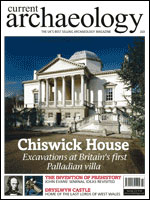This month’s issue of Current Archaeology brings you an eclectic and exciting mix of time, place and personalities. We open with a celebration of the life of an extraordinary man, Sir John Evans, a self-taught visionary who revolutionised the conventional view of the ancient world. Chiswick House, was revolutionary in its own way, too, introducing the fashion for Palladian architecture and naturalistic landscaping to Britain. But, its history stretches back further in time and using historical records and maps, archaeologists have located and uncovered the foundations of earlier buildings. Next, we move to Stoke on Trent to the tale of two farmhouses, contemporary neighbours but very different in status. Finally, we head off to Wales to discover the turbulent life of medieval Dryslwyn Castle. To round off the issue, our Editor in Chief gives his personal view of Lullingstone Roman Villa, recently re-opened after a major refurbishment by English Heritage. JOHN EVANS AND THE INVENTION OF PREHISTORYIn the brilliant mind of John Evans, geological knowledge and a lifelong fascination with antiquity collided to become the infant concept of prehistory. Detailed in his 1859 lecture to the London Society of Antiquaries, Evans’ breakthrough transformed archaeological study forever. New research marking the 100th anniversary of his death has revealed the struggle and skullduggery that was necessary in order for prehistory to take its proper place in the study of the past.THIS OLD HOUSE: EXCAVATIONS AT CHISWICKLord Burlington’s elegant London residence, Chiswick House, was the building that inspired the 18th century Palladian architectural revolution. The gardens were equally influential, and are recognised as the birthplace of the English landscape movement. Tourism has taken its toll on the Estate, and thus it is currently being revitalised by English Heritage. Recent excavations have turned up evidence of the illustrious past of this beloved London oasis.EXCAVATING FARMS IN INDUSTRIAL STOKE-ON-TRENTStoke-on-Trent was a great centre of 19th and 20th century industrialism. Famous for its Potteries, Stoke-on-Trent has previously been thought of as a textbook case of the harsh impact of industrialisation on an agricultural community. Recent archaeological work suggests something less black and white, and seems to indicate that the story may not actually be one of urban-rural dichotomy, but rather about how integrated farms were with the urban economy.DRYSLWYN CASTLE AND THE LORDS OF WEST WALESThe capture of Dryslwyn Castle in Carmarthenshire by an English army in 1287 marked the end of the hopes of the princes of Deheubarth (West Wales) to maintain their lands and status. Long ruined and largely forgotten, this last bastion of Welsh independence was the site of major excavations between 1980 and 1995. The results have just been published and we have a fascinating report.ODD SOCSThe Nomadic Preservation SocietyLAST WORDLullingstone Roman villa
Current Archaeology 223
In this issue:
-Agriculture in industrial Stoke-on-Trent
-Chiswick House
-Dryslwyn Castle, Carmarthenshire
-John Evans
-The Nomadic Preservation Society
Plus: News, Reviews, Comment, Diary, and more!
£6.95
Availability: 15 in stock
Description
Additional information
| Weight | 0.178 kg |
|---|---|
| Rest of World Delivery | £2 |
| Volume | Volume 19 |
| Published Year | 2000s |
| Cover Date | Oct-08 |
| Volume Name | Volume 19 Issue 7 |

